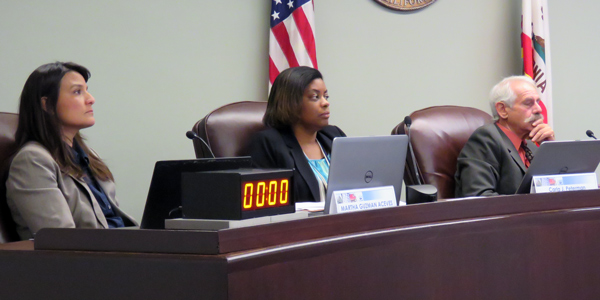By Jason Fordney
California regulators on Thursday approved an order putting new requirements on community choice aggregators (CCAs), saying the decision did not come easily.
At the same time, CCAs and their supporters are arguing for more transparency and control over resource adequacy (RA) procurement.
“I just have overwhelming anxiety about the purpose of resource adequacy,” California Public Utilities Commission President Michael Picker said, addressing a crowded hearing room at commission headquarters in San Francisco after a public comment period. “It seems as if people have forgotten the energy crisis of 2001 and 2002.”
The State Legislature authorized the creation of CCAs in 2002 in response to the energy crisis, allowing local governments to directly contract for energy services to serve their residents. CCAs did not begin appearing until 2010 but have since grown rapidly.
Until now, CCAs have avoided the requirement to carry RA reserves, even as they’ve taken on a greater share of California load. Instead, customers of investor-owned utilities have been left with stranded costs because of the timing of load forecast submissions and RA allocations, in some cases procuring RA for customers about to be served by CCAs. Cost-shifting can run into the tens of millions of dollars annually, the CPUC said.
Picker struck an assertive tone on the RA issue, saying that grid reliability is at stake as procurement of electricity disaggregates through CCAs, which he’s unsure could meet critical grid needs.
“It really makes me nervous and it makes me wonder if people are really prepared to embrace this opportunity to serve as [load-serving entities],” Picker said, adding that the CPUC made reasonable efforts to accommodate the concerns of CCA supporters.
The CPUC made changes to its initial RA proposal in response to written comments, including extending the deadline for CCAs to submit their RA implementation plans until March 1 in order to allow several of them to begin serving their new customers in 2019. The CPUC also created two waiver options, one in which CCAs and IOUs can agree on the CCA’s RA requirements and cost responsibility, and another stipulating that if agreement was not reached, the CCA agrees to be bound by a future CPUC determination in the RA proceeding regarding its RA cost responsibility.
Many of the more than 40 registered speakers attending the CPUC hearing were there to speak against the CCA ruling. West Hollywood City Councilmember Lindsey Horvath told the CPUC that CCA customer energy costs must be determined in a fair and open process.
“How can we properly determine our fair share without access to contracts we’re being asked to account for?” Horvath asked. “We are glad to see the direction the commission is moving with in the current form of its resolution, but we’re not there yet.”
The CPUC introduced the proposal in December with a comment period near the holidays, leaving CCA representatives saying the expedited order did not give them time to provide input. (See California Proposes Resource Adequacy Obligations for CCAs.) Other proponents said it would delay CCA creation and slow achievement of climate goals. CCAs have grown rapidly and are popular as a way for localities to take control of energy consumption, with many marketed as green energy options.
But Picker said that if the decision delays the implementation of CCAs, “we are just going to have to live with that.” The consequences of having grid failure “can wipe the slate clean,” he said, again invoking the reliability crisis of the early 2000s.
Commissioners appeared sympathetic to CCA supporters, but Martha Guzman Aceves said that issues with the RA program have led to more procurement of natural gas generation.
“This is a problem to reaching our climate goals,” she said. “This is actually an environmental justice issue for me.” She added that, “Sometimes we don’t use the best process, I totally acknowledge that. But we need to deal with this problem now.”
“There has got to be good dialogue, there has to be trust,” Commissioner Carla Peterman said. “The last thing I want is to exacerbate tension between the CCAs, the utilities and the commission.”
The CPUC has also targeted reliability-must-run payments from CAISO to Calpine for natural gas units, another result of the RA problems. (See California CCAs Spur Worry of Regulatory Crisis.)
In its order, the CPUC said: “Numerous commenters assert that the resolution violates their due process rights. We disagree. The changes in the CCA timeline made by this resolution are an exercise of authority the commission has had since 2002.”
Decision Adopts IRP Process
Another decision approved by the CPUC on Thursday sets RA requirements for all California LSEs. It institutes a two-year integrated resource planning process including electrical cooperatives, IOUs, CCAs and electric service providers.
The decision also recommends the state’s Air Resources Board adopt a greenhouse gas emissions target for the electric sector of 42 million metric tons by 2030, a 50% reduction from 2015 levels.
CPUC Delays Gas Moratorium Vote
In other items on the CPUC decision list, the commission tabled a proposal to require Southern California Gas to enact a moratorium on new commercial and industrial natural gas connections in Los Angeles County because of supply issues.
The CPUC said that while conservation measures by customers in response to the Aliso Canyon storage facility have helped, “significant new reliability challenges on the SoCalGas system exist due to a series of major unplanned outages and maintenance issues. The Los Angeles region faces greater uncertainty than a year ago with respect to the ability of SoCalGas to meet customer demand this winter.”





